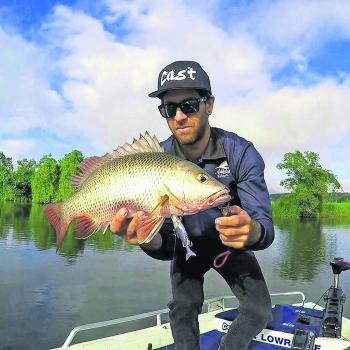Mangrove jack have a well-known reputation as fearsome fighting fish that strike like lightning and pull like a steam train towards any available cover, normally taking everything with them.
Some people call this species a dirty fighter, but anyone experienced in catching mangrove jack knows that the angler is the one who needs to be ready and have the correct equipment to have any chance of success.
These fish can be found in both offshore reefs and estuarine systems. They thrive on areas that allow them to ambush food. The more clutter in the water, the better chance there is of taking a fish. Mangrove jacks are highly territorial and will defend their spot aggressively. Smaller fish live their juvenile lives in the protection of the mangrove waterways, bridges, pontoons, underwater snags, rocky outcrops and deep holes. Once they reach around 2-4kg they start to move out into the open ocean where they live out their lives.
Fishing for mangrove jacks will keep you thinking constantly. The moment you stop thinking, the fish will stop biting. You need to look for likely areas that will hold jacks; check out where you are going to present your lure or bait, watch the sounder for drop-offs or likely holding spots and use the tidal run to your advantage.
There are two effective ways to catch jacks. These include baiting or lure fishing with both soft plastics and hardbodied lures. Bait is bait, but live bait is on a completely different level and essential to target mangrove jacks. Live prawns, poddy mullet, herring, whiting and crab are among the best choices to greatly increase your chances.
Important note – if you aren’t right up in the snags or rocks you aren’t in the strike zone. Losing some of your rigs or lures means that you are right in the snaggy areas where they live.
When jack spots your bait it will fly out of its cover, then turn around and take the bait straight back from where it came. These fish hit hard and fast, so it’s smart to strike on the first nudge of the line. If you don’t put immediate pressure on them, they will make it back to the snag and it’s all over. So strike fast, lock the fish up and turn it away from there.
Standard spin outfits will do these days but I use a baitcaster outfit so that I can get into tight places with my bait or lure. The main line should be 15-20lb with a high abrasion resistant leader of 15-20lb for the basic set up. I prefer braid, but mono will do the job if you strike fast. Rods in the 3-6kg or 5-10kg range are good to get the job done. You don’t need the best of the best in rods to catch more fish. As far as fluorocarbon goes, my experience has been the same catch of fish at this stage with or without.
Effective lures range from shallow to deep divers depending on where you are fishing. My favourites are Yo Zuri Crystal Minnows, Lucky Craft poppers for surface work and 3.5” Bombers. In soft plastics, I can’t go past the Prawnstar Gold range or DOA Shrimp. Z-Man 100mm and Gulp paddle tails or minnows are the pick of the others. I always use as light a jighead as possible to get right into the spot so that it sinks down slowly into the strike zone, presenting more naturally. A heavier jighead will sink fast and be out of the strike zone too quickly.
The normal lift-and-twitch technique is a killer. Remember to leave the lure or bait in the strike zone as long as possible. It’s a well-known fact that most fish feed into the current, and mangrove jack are no different.
When rigging with live bait I use a 2/0-4/0 short shank hook. Live bait can be cast close into the snaggy areas or trolled slowly past likely spots. If you are trolling, get in as close as possible to the snags. When fishing live baits you much watch your line at all times. If there is the slightest twitch, strike.
Everyone has his or her own opinion on this, but day or night you can catch mangrove jack. A making tide or last of the low is my favourite time to catch them because the fish are all congregated in deeper pool areas. There needs to be run in the tide or it is very difficult to entice them. Remember – no run, no fun! Summer time is the best time to target them. Once you know the areas they like to haunt you’ll find them there all year round.
These days there is a lot more pressure in the backwater areas because technology allows us to get there easily with electric motors and kayaks, so plan your trip carefully. Fish when there are fewer anglers on the water. Mangrove jack will spook if there is a lot of noise but sometimes you’ll need to mix up your attack. Keep casting to the area until you are convinced there is nothing there. Annoy them enough and watch the way they retaliate.
Mangrove jack are worth putting in the hours of fishing to get the results but is not something you should do half-heartedly. If you are fishing for them, focus only on jack – if you change it up and start looking for bream or a flathead with the hope of a jack on the side, you will be disappointed.
| Once you have experienced the smash and grab of jack you will want more and more. Please remember that we all | deserve a chance to fish for them, so release what you don’t need for the table. |
|---|

Justin Peacock loves chasing mangrove jacks.

Shane Adams with a healthy winter jack.

Justin Peacock with another jack from the canals.

You can catch some good jacks around Noosa.




